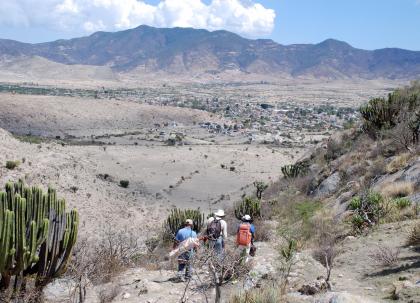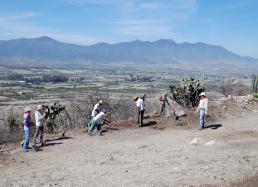1: Off to a Good Start for Year Two at the Mitla Fortress
After more than 30 years, archaeological field seasons for me always start with a mix of excitement, anxiety, eager anticipation about what is to be found, and worries about what got left behind. Bearing this emotional cocktail, my wife and collaborator, Linda Nicholas, and I set off from Chicago heading just about straight south from the midwestern winter into the warmth and green of southern Illinois, southern Missouri, Arkansas, and then the summer-like heat of southern Texas.
When speaking with people in the States, they often wonder why we take the time to drive to Mexico. The simple answer is that we need a reliable vehicle when in Oaxaca, as well as a way to bring certain supplies and essentials to the field from Chicago. Yet behind the functional rationale is the reality that we enjoy the drive as a chance to mentally re-set, and as a way to understand the context of our excavations, ensconced in a broad Y-shaped valley, tucked within the Sierra Madre del Sur range of mountains.
Mitla, known for its elaborate archaeological palaces and for the anthropologist Elsie Clews Parsons’ wonderfully descriptive 70-year-old volume (Mitla: Town of Souls), has been our base of fieldwork operations for more than a decade and a half. Yet we've only actually carried out archaeology in the lands of Mitla a few of those years. Nevertheless, we have many friends and acquaintances here, and so after four days on the road, it's always more than welcome to be greeted on a warm Sunday afternoon with “Que Milagro!” (“What a miracle!”) by the people who you last bid “adios” nine months past.
This year, our drive down was particularly enjoyable, as we were able to bypass entirely the traffic and bustle of Mexico City for the first time, with the completion of a new toll road that cuts through the scenic mountains and high mesas north and east of Mexico’s capital. (If the truth be told, Mexico City is a fabulous destination, but it's easiest to enjoy when you don't have to drive.)
Following our arrival in Mitla, the first week of set-up also went well. We were able to rent the houses and the lab that we wanted, and more importantly, the entire permit process went smoothly. Last year, our first at the Mitla Fortress, went exceedingly well, and we received great assistance and understanding from governing officials at all levels. But at times in 2009, long-standing differences and political jockeying between different governing authorities bubbled up in a manner that presented challenges to us.
This year, at least at the start, any such issues have been resolved and no such difficulties have arisen. We're grateful to the officials of the Mexican National Institute of Anthropology and History, their office in Oaxaca, and all the municipal and communal land-holding authorities of San Pablo Villa de Mitla for their help and support. Without all of their backing, this fieldwork project and these dispatches describing our efforts wouldn't be possible.
Besides housing, permits, packing, and shopping, our first week in Oaxaca also focused on recruiting our crew of Mitleños. Fortunately, we were able to hire roughly half of the workers that we had with us last year, which is wonderful since they are already trained and familiar with the procedures of our work.
At the end of the first week, we also picked up the first members of our North American team to arrive. Hilary (University of Illinois undergraduate), Kara (Field Museum volunteer), and Heather (intern scientific illustrator from Iowa State University) flew down together, arriving in the city of Oaxaca from Chicago.
Before their arrival, Linda and I along with our two Mitla foremen, Rolando and Juan, prepped for our first full day in the field on Thursday by first making sure that our 2-km route to the Mitla Fortress from the town of Mitla was clear of obstructing rocks and tire-piercing thorns. On Friday, we selected the terrace to excavate and used the laser transit to lay down a numerical grid of 2x2-m units within which we aim to excavate (see Photo #1 below.)
The terrace we selected is immediately adjacent to (east of) the terrace that we studied in 2009. We chose this adjacent terrace because we hope to establish that some of the broad-brush patterns that we noted last year—in terms of the architectural use of the 2009 terrace (terrace 56) over time, the nature of the artifacts that we recovered, and our general interpretations—were not completely anomalous.
Although our first week was unquestionably productive, a few small dark clouds did hang literally and figuratively over the mountains. For one, on Friday while up at the site laying the grid, we noted that the ant disturbance on the terrace that we wanted to investigate (terrace 57) was deeper and more destructive than what we first thought. This could become an issue.
In addition, it rained twice at night that first week—one storm prompted an electrical blackout covering all of Mitla for several hours. If it's raining like that during the height of the dry season, this feels like an atypical weather year. In contrast to the desires of farmers, when conducting excavations on a hill, the rain is not particularly welcome.
Words of the Day: agua cerro, which literally means “water from the mountains.” An agua cerro is a strong, violent storm that emerges from the mountains, often accompanied by hail, thunder, and lightning. Here, where air pockets and fronts of different temperatures often collide, agua cerros are generated especially in the spring and summer.
More soon,
Gary





